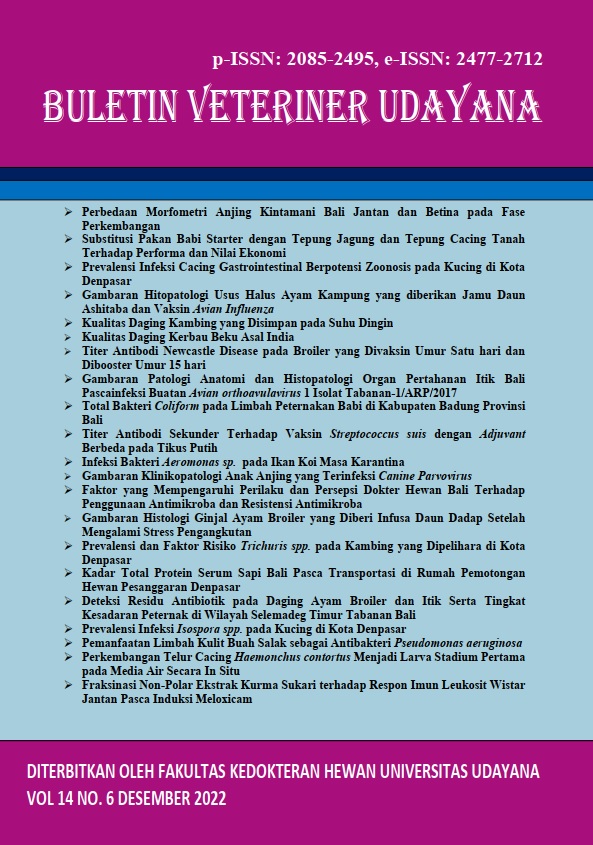THE DEPELOPMENT OF HAEMONCHUS CONTORTUS EGGS TO FIRST STAGE LARVAE IN LIQUID MEDIA IN SITU
Abstract
Haemonchus contortus is a highly pathogenic worm in sheep and goats. A study was conducted to determine the in situ percentage of the development of H. contortus worm eggs at the first-stage larvae (L1) in water. This research treatment was repeated 5 times in one group with a duration of 10 days and each group used 8 female H. contortus worms. These worm eggs are counted using the McMaster method. The prepared worm samples were ground, immersed in 5 mL of pro-injection aqua (pH 7.0), and filtered using a tea filter. Research procedure: 1.5 mL of suspension was collected, placed into a tube and treated according to the procedure. Each tube, covered with aluminium foil that has holes 15 to 20, was placed on pasture for 48 h (05:00 – 24:00); where ambient temperature was recorded every four hour. Research variable include: percentage of hatched worm eggs in the immersion group. The hatchability percentage = ((the difference between numbers of worm eggs before and after treatment): (those before treatment) x 100)). Data were tabulated and analysed descriptively. The results showed that: the percentage of the total average development of the L1H. contortus worm eggs was 26.5%. Conclusion: the percentage of egg development of H. contortus in situ was 26.5%. The influencing factors are ambient temperature, pH, humidity, culture media, and egg abnormalities. It is recommended to extend the breeding time in the media in the hope that the percentage yield is more optimal.
Downloads
References
Badan Meteorologi, Klimatologi, dan Geofisika (BMKG) Kota Kupang (2022). Prakiraan cuaca Provinsi Nusa Tenggara Timur.
Bekuma F, Dufera B. 2019. Prevalence of heamonchosis in small ruminants and its associated risk factors in and Around Ejere Town, West Shoa, Oromia, Ethiopia. Am. J. Biomed. Sci. Res. 3(5): 409-414.
Coles GC, Jackson F, Pomroy WE, Prichard RK, Samson-Himmels, Gvon T, Silvestere A, Taylor MA, Vercruysse J. 2006. The detection of anthelmintic resistance in nematodes of veterinary importance: review. Vet. Parasitol. 136: 167-185.
Emery DL, Hunt PW, Le Jambre LF. 2016. Haemonchus contortus: the then and now, and where to from here (Invited Review). Int. J. Parasitol. 46: 755–769.
Iliev P, Prelezov P, Ivanov A, Kirkova Z, Kalkanov I. 2017. Effect of temperature and desiccation on some exogenous stages of Haemonchus contortus. Bulg. J. Vet. Med. 20(1): 374–377.
Khatun F, Begum M, Akter S, Mondal M. 2013. In vitro study of environmental and nutritional factors on the hatching and development of eggs of Haemonchus contortus. Bangladesh Vet. 30(1): 1-9.
Mahmood OI, Muhsin SN, Hussein M. 2019. Morphological diagnosis for some eggs of gastrointestinal nematodes from sheep. Tikrit. J. A. Sci. 19(3): 6-9.
Morgan ER, Dijk JV. 2012. Climate and the epidemiology of gastrointestinal nematode infections of sheep in Europe. Vet. Parasitol. 189(1): 8-14.
Rajib SMFR, Dey AR, Begum N, Momin MA, Talukder MH. 2014. Prevalence and in vitro culture of Trichostrongylus spp. in goat at Trishal, Mymensingh, Bangladesh. J. Adv. Parasitol. 1(4): 44-48.
Sutherland I, Scott I. 2010. Gastrointestinal nematodes of sheep and cattle. First Edition. Wiley-Blackwell.
Taylor MA, Coop RL, Wall RL. 2007. Veterinary parasitology. Third Edition. Blackwell Publishing Ltd, 9600 Garsington Road, Oxford OX4 2DQ, UK.
Yuswandi, Rika YS. 2015. Studi biologi larva dan cacing dewasa hemonchus contortus pada kambing a biological study of larvae and adult hemonchus contortus in goat. J. Sain. Vet. 33(1): 42-52.
Zaman MA, Iqbal Z, Khan MN, Muhammad G. 2012. Anthelmintic activity of a herbal formulation against gastrointestinal nematodes of sheep. Research Article. Pak. Vet. J. 32(1): 117-121.





